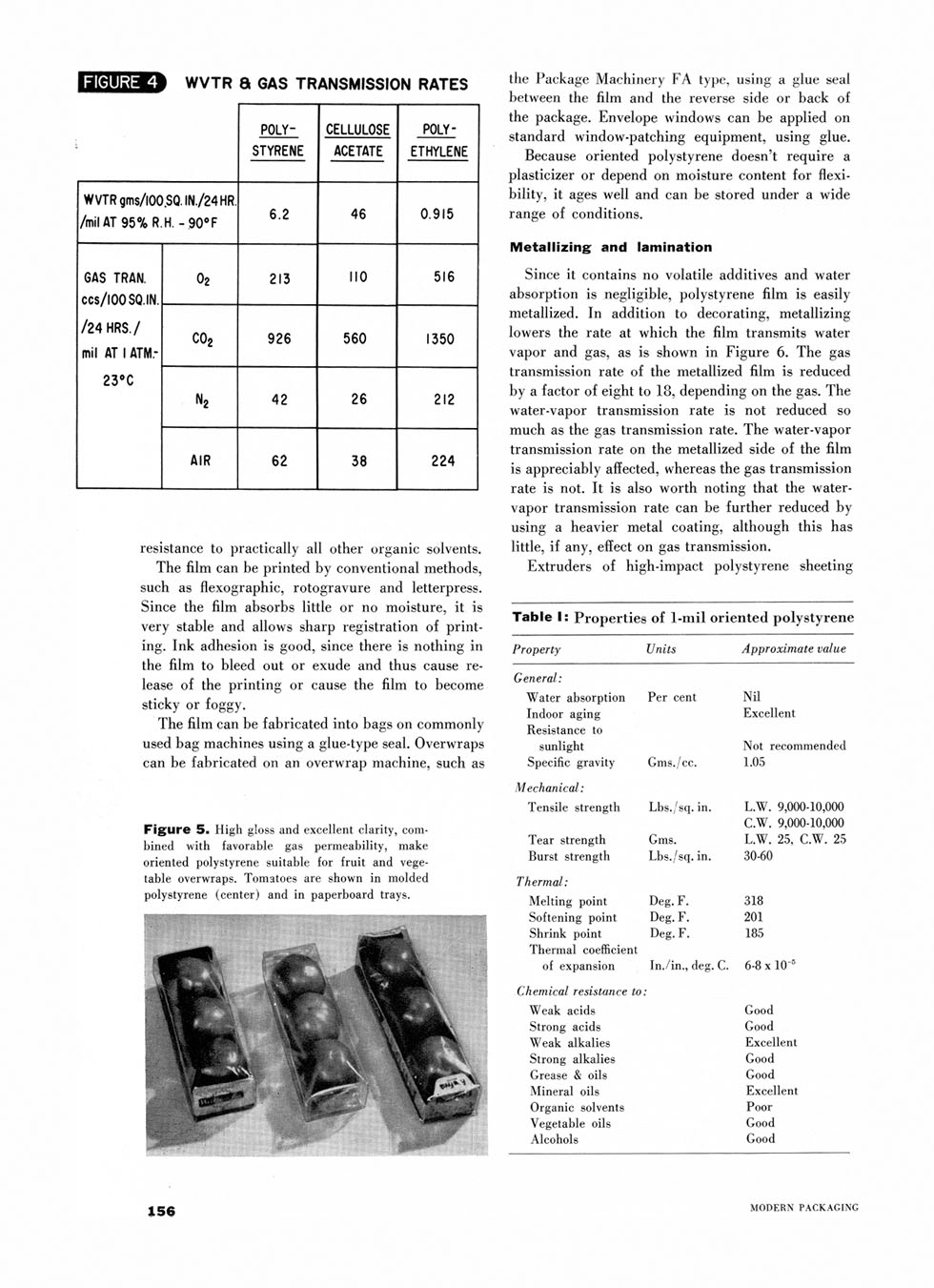


i¾i⅞lls⅛⅜ WVTR a GAS TRANSMISSION RATES
|
P0LY" STYRENE |
CELLULOSE ACETATE |
POLY- ETHYLENE | ||
|
WVTR gms/lOO.SQ. IN./24 HR. /mil AT 95% R.H - 90°F |
6.2 |
46 |
0.915 | |
|
GAS TRAN. ccs/lOOSQ.IN. /24 HRS./ mil AT 1 ATM-23#C |
(⅛ |
213 |
110 |
516 |
|
co2 |
926 |
560 |
1350 | |
|
h |
42 |
26 |
212 | |
|
AIR |
62 |
38 |
224 | |
resistance to practically all other organic solvents.
The film can be printed by conventional methods, such as flexographic, rotogravure and letterpress. Since the film absorbs little or no moisture, it is very stable and allows sharp registration of printing. Ink adhesion is good, since there is nothing in the film to bleed out or exude and thus cause release of the printing or cause the film to become sticky or foggy.
The film can be fabricated into bags on commonly used bag machines using a glue-type seal. Overwraps can be fabricated on an overwrap machine, such as
Figure 5. High gloss and excellent clarity, combined with favorable gas permeability, make oriented polystyrene suitable for fruit and vegetable overwraps. Tomatoes are shown in molded polystyrene (center) and in paperboard trays.
the Package Machinery FA type, using a glue seal between the film and the reverse side or back of the package. Envelope windows can be applied on standard window-patching equipment, using glue.
Because oriented polystyrene doesn't require a plasticizer or depend on moisture content for flexibility, it ages well and can be stored under a wide range of conditions.
Metallizing and lamination
Since it contains no volatile additives and water absorption is negligible, polystyrene film is easily metallized. In addition to decorating, metallizing lowers the rate at which the film transmits water vapor and gas, as is shown in Figure 6. The gas transmission rate of the metallized film is reduced by a factor of eight to 18, depending on the gas. The water-vapor transmission rate is not reduced so much as the gas transmission rate. The water-vapor transmission rate on the metallized side of the film is appreciably affected, whereas the gas transmission rate is not. It is also worth noting that the water-vapor transmission rate can be further reduced by using a heavier metal coating, although this has little, if any, effect on gas transmission.
Extruders of high-impact polystyrene sheeting
|
Table 1; Properties of 1-mil oriented polystyrene | ||
|
Property |
Units |
Approximate value |
|
General: | ||
|
Water absorption |
Per cent |
Nil |
|
Indoor aging |
Excellent | |
|
Resistance to | ||
|
sunlight |
Not recommended | |
|
Specific gravity |
Gms./cc. |
1.05 |
|
Mechanical: | ||
|
Tensile strength |
Lbs., sq. in. |
L.W. 9,000-10,000 C.W. 9,000-10,000 |
|
Tear strength |
Gms. |
L.W. 25, C.W. 25 |
|
Burst strength |
Lbs./sq. in. |
30-60 |
|
Thermal: | ||
|
Melting point |
Deg. F. |
318 |
|
Softening point |
Deg. F. |
201 |
|
Shrink point |
Deg. F. |
185 |
|
Thermal coefficient | ||
|
of expansion |
In./in., deg. C. |
6-8 x lO 5 |
|
Chemical resistance to | ||
|
Weak acids |
Good | |
|
Strong acids |
Good | |
|
Weak alkalies |
Excellent | |
|
Strong alkalies |
Good | |
|
Grease & oils |
Good | |
|
Mineral oils |
Excellent | |
|
Organic solvents |
Poor | |
|
Vegetable oils |
Good | |
|
Alcohols |
Good | |